初中英语北师大版教材
新北师大版七年级英语上册电子课本

新北师大版七年级英语上册电子课本第一单元:My Classmates1.1 重点词汇1. classmate2. teacher3. student4. friend5. man6. woman7. school8. class9. floor10. desk1.2 语法点1. 一般现在时2. 名词所有格1.3 功能句型1. What's your name?2. My name is...3. What class are you in?4. I'm in Class...5. What does your mother do?6. She's a...第二单元:My Family 2.1 重点词汇1. family2. father3. mother4. brother5. sister6. son7. daughter8. grandma9. grandpa10. uncle2.2 语法点1. 一般现在时2. 家庭成员的介绍2.3 功能句型1. This is my...2. She's a...3. He's a...4. They are...第三单元:My School3.1 重点词汇1. school2. subject3. teacher4. student5. class6. library7. laboratory8. playground9. basketball10. football 3.2 语法点1. 一般现在时2. 名词所有格3.3 功能句型1. What subject do you like?2. I like...3. What time does your class start?4. It starts at...第四单元:My Hobbies4.1 重点词汇1. hobby2. read3. write4. swim5. play6. listen7. music8. watch9. movie10. sports4.2 语法点1. 一般现在时2. 动词短语4.3 功能句型1. What's your hobby?2. I like...3. Do you like...?4. Yes, I do. No, I don't.第五单元:Food and drinks 5.1 重点词汇1. food2. drink3. meat4. fish5. vegetable6. fruit7. rice8. bread9. milk10. water5.2 语法点1. 一般现在时2. 食物和饮料的名称5.3 功能句型1. What do you like to eat/drink?2. I like...3. Do you like...?4. Yes, I do. No, I don't.第六单元:Healthy Lifestyle6.1 重点词汇1. healthy2. lifestyle3. exercise4. sleep5. diet6. smoke7. drink8. coffee9. tea10. sugar6.2 语法点1. 一般现在时2. 形容词和副词6.3 功能句型1. What's a healthy lifestyle?2. A healthy lifestyle includes...3. Do you have a healthy lifestyle?4. Yes, I do. No, I don't.第七单元:Animals7.1 重点词汇1. animal2. cat3. dog4. fish5. bird6. elephant7. tiger8. lion9. bear10. panda7.2 语法点1. 一般现在时2. 动物的名称7.3 功能句型1. What's this animal?2. It's a...3. Do you like this animal?4. Yes, I do. No, I don't. 第八单元:Seasons 8.1 重点词汇1. season2. spring3. summer4. autumn5. winter6. hot7. cold8. warm9. cool10. sunny8.2 语法点1. 一般现在时2. 季节的名称和描述8.3 功能句型1. What season is it?2. It's...3. Do you like this season?4. Yes, I do. No, I don't.参考答案请参考课本末尾的参考答案部分,以获取本册英语电子课本的练题和测试题的答案。
新北师大版初中英语八年级上册课本词汇表
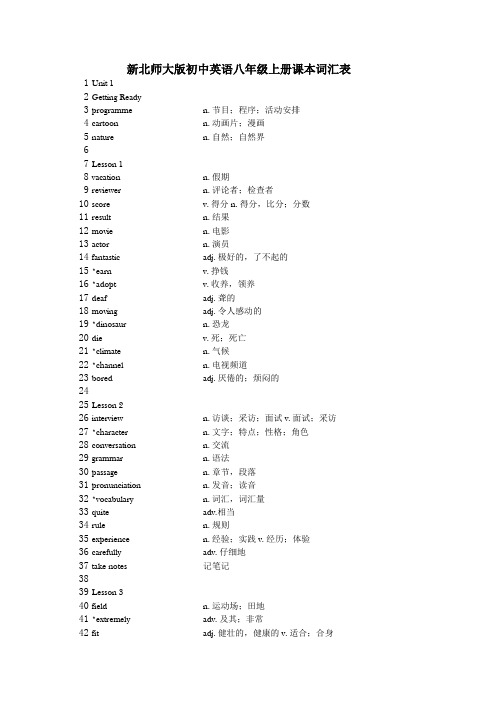
v. 得分 n. 得分,比分;分数
11 result
n. 结果
12 movie
n. 电影
13 actor
n. 演员
14 fantastic
adj. 极好的,了不起的
15 *earn
v. 挣钱
16 *adopt
v. 收养,领养
17 deaf
adj. 聋的
18 moving
adj. 令人感动的
19 *dinosaur
adv. 仔细地
37 take notes
记笔记
38
39 Lesson 3
40 field
n. 运动场;田地
41 *extremely
adv. 及其;非常
42 fit
adj. 健壮的,健康的 v. 适合;合身
43 agree 44 certainly 45 pass 46 *goal 47 score a goal 48 kick 49 basket 50 make a basket 51 *foul 52 kid 53 call 54 terrible 55 shame 56 What a shame! 57 should 58 *complain 59 hit 60 *court 61 form 62 in top form 63 win 64 break 65 prize 66 lose 67 fall 68 69 Communication Workshop 70 magic 71 *tortoise 72 run after 73 deer 74 sky 75 *whale 76 *ocean 77 photographer 78 cameraman 79 *host 80 explain 81 habit 82 *scenery 83 explanation 84 continue 85
Unit 4 Interests and Abilities L2 七年级上英语(北师大版2024)
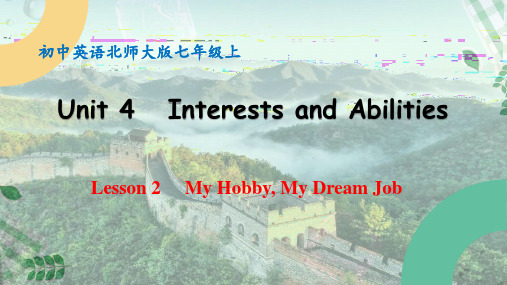
There be can是情态动词,可以用于表达能力。
Your Discovery
Grammar in Use
Look at the table. What can/can't the students do? Complete the sentences.
Express Yourself Talk about your hobbies, questions below to help you.
Read and Understand
What do you know about each person's hobby, ability and dream job? Read the texts again and complete the notes.
Read and Understand Work in groups. Choose one person from the texts. Introduce him/ her to your group members. Use your notes in Activity 3 to help you.
Read and Understand
Who are the four students and where are they from? Read the texts below and find out.
Name: Janusz Age: 13 Country: Poland I'm crazy about reading. Reading makes me relaxed. I read a lot and I can write good stories. My favourite writer is Charles Dickens. My dream is to be a writer like him.
北师大版初中英语教材英语哪个单元是讲交通方式
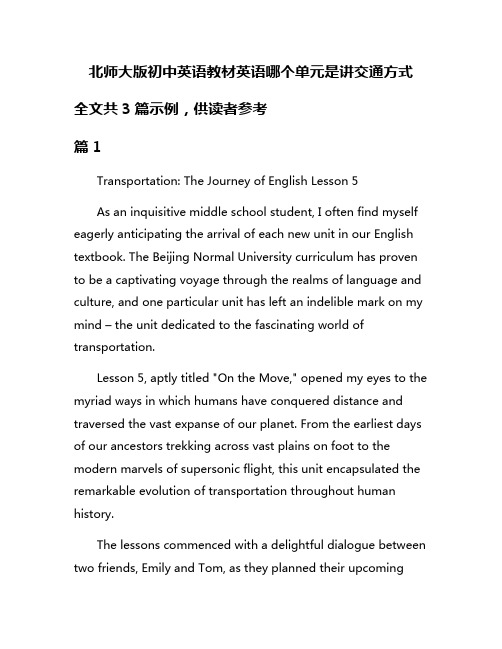
北师大版初中英语教材英语哪个单元是讲交通方式全文共3篇示例,供读者参考篇1Transportation: The Journey of English Lesson 5As an inquisitive middle school student, I often find myself eagerly anticipating the arrival of each new unit in our English textbook. The Beijing Normal University curriculum has proven to be a captivating voyage through the realms of language and culture, and one particular unit has left an indelible mark on my mind – the unit dedicated to the fascinating world of transportation.Lesson 5, aptly titled "On the Move," opened my eyes to the myriad ways in which humans have conquered distance and traversed the vast expanse of our planet. From the earliest days of our ancestors trekking across vast plains on foot to the modern marvels of supersonic flight, this unit encapsulated the remarkable evolution of transportation throughout human history.The lessons commenced with a delightful dialogue between two friends, Emily and Tom, as they planned their upcomingvacation. The witty banter and relatable scenarios immediately drew me into the narrative, making the acquisition of new vocabulary and grammar structures an engaging and enjoyable process. Words like "commute," "transit," and "journey" took on new significance as I explored their nuances and applications.As the unit progressed, we delved into the intricacies of various modes of transportation, each one a testament to human ingenuity and perseverance. The humble bicycle, often overlooked in our fast-paced world, was celebrated for itseco-friendly nature and the sheer joy it brings to riders of all ages. I fondly recall the vivid descriptions of cycling through picturesque countryside landscapes, the wind whispering through my hair, and the sense of freedom that accompanies this simple yet exhilarating form of travel.However, the true marvel of modern transportation lies in the realm of aviation. The unit dedicated an entire chapter to the wonders of air travel, from the pioneers who dared to defy gravity to the cutting-edge technology that propels massive jetliners across continents in a matter of hours. I was captivated by the intricate mechanics of flight, the physics behind lift and thrust, and the sheer audacity of mankind's quest to conquer the skies.Yet, amidst the awe-inspiring feats of engineering, the unit also prompted us to contemplate the environmental impact of our transportation choices. We explored alternative modes of transportation, such as electric vehicles and high-speed rail, which promise to reduce our carbon footprint while maintaining the convenience and efficiency we've come to expect in the modern age.Beyond the technical aspects, the unit also delved into the cultural implications of transportation. We explored how different modes of travel have shaped societies, facilitated the exchange of ideas, and brought people from diverse backgrounds together. The stories of ancient trade routes, such as the Silk Road, and the challenges faced by modern-day migrants and refugees, reminded me of the profound impact that transportation has had on the human experience.As I reflect on this unit, I am filled with a profound sense of gratitude for the knowledge it imparted and the doors it opened to new perspectives. The lessons not only expanded my English proficiency but also ignited a curiosity about the world around me. I find myself observing the intricate web of transportation systems that seamlessly connect our cities, nations, andcontinents, marveling at the accomplishments of human innovation and resilience.Moving forward, I carry with me the invaluable lessons from "On the Move," inspired to continue exploring the boundless potential of transportation and its role in shaping our global society. Perhaps one day, I will contribute to the next great leap in human mobility, propelling us towards new frontiers and fostering greater understanding and cooperation among all people.In the end, this unit serves as a powerful reminder that language is not merely a collection of words and rules; it is a gateway to understanding the vast tapestry of human experience, and transportation stands as a shining example of our species' relentless pursuit of progress and connection.篇2A Confusing Yet Enlightening Lesson on TransportationAs an eager middle school student, I found myself frequently puzzled by the intricacies of the English language. One unit that particularly stood out to me was the unit on transportation in our Beijing Normal University English textbooks. At first glance, it seemed like a straightforward topic, but as I delved deeper, Iquickly realized that it was a labyrinth of vocabulary, grammar rules, and cultural nuances.The unit commenced with an introduction to various modes of transportation, ranging from the mundane to the extraordinary. We learned about cars, buses, trains, and airplanes, but also delved into more unique forms of transportation like hot air balloons and cable cars. Each new term felt like a foreign melody, challenging my tongue to dance to unfamiliar rhythms.One particular aspect that caught my attention was the vast array of verbs associated with transportation. Words like "drive," "ride," "fly," and "sail" took on new dimensions as we explored their nuanced meanings and usage. I vividly remember the confusion that ensued when our teacher explained the difference between "riding a bicycle" and "riding on a bicycle." It felt as though the English language was playing a mischievous trick on us, with subtle distinctions that could easily trip up even the most diligent learners.As we ventured further into the unit, we encountered the complexities of prepositions and their role in describing directions and locations. Phrases like "across the bridge," "along the river," and "through the tunnel" became our constant companions, weaving intricate tapestries of meaning. I'll neverforget the countless times I stumbled over the appropriate preposition to use, only to be gently corrected by our patient teacher.One aspect that fascinated me was the cultural significance of transportation in various societies. We learned about the iconic double-decker buses in London, the efficient subway systems in Tokyo, and the romantic gondolas in Venice. These glimpses into different cultures opened my eyes to the ways in which transportation not only facilitates movement but also shapes the identities and traditions of people around the world.Perhaps the most challenging aspect of this unit was mastering the art of giving and following directions. We practiced dialogues where we had to navigate imaginary streets, take turns at intersections, and provide clear instructions using cardinal directions, landmarks, and distance measurements. It was a test of our comprehension, memory, and ability to communicate effectively – a skill that would prove invaluable in our future travels and explorations.As we neared the end of the unit, our teacher introduced us to the world of idioms and expressions related to transportation. Phrases like "hitting the road," "jumping on the bandwagon," and "being in the driver's seat" took on new meanings, addingdepth and color to our understanding of the English language. It was as if a veil had been lifted, revealing the rich tapestry of figurative language woven into the fabric of everyday speech.Looking back, the transportation unit in our Beijing Normal University English textbooks was a rollercoaster ride of challenges and revelations. It pushed us to expand our vocabulary, grapple with complex grammar rules, and embrace the cultural nuances that give language its vibrant life. Though the journey was often arduous, the sense of accomplishment upon mastering each concept was unparalleled.Today, as I navigate the world with confidence, I can't help but reflect on the invaluable lessons I learned from that unit. Whether I'm catching a flight, hailing a taxi, or simply giving directions to a friend, the skills I acquired have become an integral part of my life. The English language, once a daunting maze, has now become a familiar landscape, and I owe a debt of gratitude to the dedicated teachers who guided me through the winding roads of the transportation unit.篇3Modes of Transportation: A Look at Unit 5 of the BNU English TextbookAs an eighth-grader, one of the units that really stuck out to me in our Beijing Normal University (BNU) English textbook was Unit 5 – "On the Move." This particular unit was all about different modes of transportation, and it was definitely an interesting and engaging topic to learn about.To be honest, before studying this unit, I didn't give much thought to the various ways we get around. I mean, I knew there were cars, buses, trains, and planes, but that was about the extent of it. However, after delving into Unit 5, my eyes were opened to the vast array of transportation methods available to us.One of the first things we learned about was the different types of vehicles on the road. Sure, we all know about cars and buses, but did you know there are so many subcategories within those broader terms? We studied everything from sedans and SUVs to minivans and pickup trucks. And when it came to buses, we learned about tour buses, double-deckers, and even those nifty little shuttle buses you see at airports and resorts.But it wasn't just about vehicles on the road. Unit 5 also introduced us to other modes of transportation like trains, subways, and even boats and ships. I found the section on trains particularly interesting, especially when we learned about thedifferent types, such as high-speed rail, commuter trains, and freight trains. It was mind-boggling to think about how these massive machines could transport people and goods across vast distances.Of course, we couldn't talk about transportation without discussing air travel. Unit 5 covered everything from commercial airliners to private jets and even helicopters. I remember being fascinated by the mechanics of flight and the sheer engineering feat it is to get a massive metal tube filled with people and cargo soaring through the sky.But perhaps the most eye-opening part of Unit 5 was learning about some of the more unconventional modes of transportation. We studied things like cable cars, funiculars (those nifty little inclined railways), and even gondolas – you know, those romantic Venetian boats that glide along the canals. It was incredible to see the variety of ways humans have found to get from point A to point B.Throughout the unit, we not only learned about the different modes of transportation but also the vocabulary associated with each one. We studied words like "terminal," "platform," "cabin," and "cockpit." We even learned some more technical terms like "aerodynamics" and "propulsion."But it wasn't just about memorizing vocabulary words. Unit 5 also incorporated various language skills, such as reading comprehension passages about transportation history or listening exercises where we had to identify different modes of transport based on sound clips. We even had to write our own short essays describing our preferred method of travel and why.One of the things I really appreciated about this unit was how it tied in with our daily lives. We live in a world where transportation is so integral to our existence, yet we often take it for granted. Unit 5 helped us appreciate the complexity and ingenuity behind the various modes of transportation we rely on every day.Moreover, the unit encouraged us to think critically about the pros and cons of different transportation methods. We discussed topics like environmental impact, efficiency, and accessibility. It was fascinating to weigh the benefits of something like air travel (speed and convenience) against the drawbacks (pollution and carbon emissions).All in all, Unit 5 of our BNU English textbook was a realeye-opener for me. It took something as mundane as getting from one place to another and transformed it into a rich,multifaceted topic that encompassed vocabulary, language skills, history, engineering, and even environmental considerations.As a student, I found the unit engaging and informative, and it definitely broadened my perspective on the world of transportation. Who knew something as simple as learning about buses, trains, and planes could be so fascinating? Thanks to Unit 5, I'll never look at my morning commute the same way again.。
初中英语北师大版(2024)七年级上册《Section 3 Saying Hello》教学设计

设计意图:系统地展示本节课的重点问候语及其回应方式,让学生有一个整体的认识。
教师利用多媒体展示不同的时间和场景图片,如早晨的校园、下午的公园、晚上的家庭聚会等。
针对早晨的校园图片,教师说:“When we meet in the morning at school, we can say 'Good morning'.” 并让学生跟着重复几遍,同时在黑板上写下 “Good morning”。然后教师模拟对话场景,问学生:“Good morning. How are you today?” 引导学生回答:“Fine, thank you. And you?” 教师解释这是一种常见的回应方式,并在黑板上相应位置写下。
教师走进教室,热情地用简单的问候语 “Hello, boys and girls!” 与学生打招呼,然后在黑板上写下 “Hello” 这个词。接着提问学生:“In our daily life, we often say hello to others. Can you tell me some other ways to say hello in English?” 引导学生回忆已学的问候语,如 “Hi” 等。如果学生能说出一些,教师给予肯定和表扬;如果学生回答不上来,教师可以简单提示,如 “Good...”。
在这个过程中,教师提醒学生注意根据不同的角色和场景使用合适的问候语,并且要注意表情和肢体语言,使交流更加自然。
小组展示:
每个小组推选两名学生,在全班同学面前进行一个简单的问候场景展示。例如,一名学生扮演外国友人来中国旅游,另一名学生扮演导游。他们要展示从初次见面到相处过程中的问候交流。展示结束后,其他小组的同学可以进行评价,如 “Your pronunciation of 'Nice to meet you' is very good” 或者 “I think you should use 'Good afternoon' instead of 'Good morning' in this scene”。
【北师大版】初中英语7-9年级(共6册)教材目录
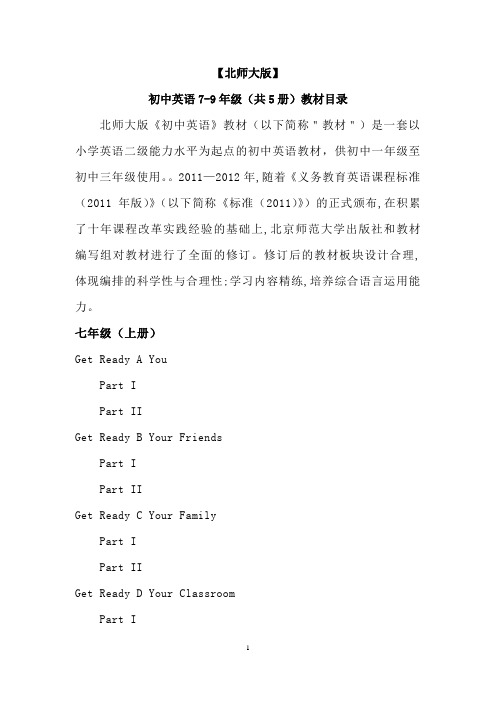
【北师大版】初中英语7-9年级(共5册)教材目录北师大版《初中英语》教材(以下简称"教材")是一套以小学英语二级能力水平为起点的初中英语教材,供初中一年级至初中三年级使用。
2011—2012年,随着《义务教育英语课程标准(2011年版)》(以下简称《标准(2011)》)的正式颁布,在积累了十年课程改革实践经验的基础上,北京师范大学出版社和教材编写组对教材进行了全面的修订。
修订后的教材板块设计合理,体现编排的科学性与合理性;学习内容精练,培养综合语言运用能力。
七年级(上册)Get Ready A YouPart IPart IIGet Ready B Your FriendsPart IPart IIGet Ready C Your FamilyPart IPart IIGet Ready D Your ClassroomPart IPart IIGet Ready E Your RoomPart IPart IIUnit 1 FamilyLesson 1 Photos of UsLesson 2 What Do They Look Like?Lesson 3 Happy Birthday!Communication WorkshopUnit 2 School LifeLesson 4 School ThingsLesson 5 Before ClassLesson 6 A School DayCommunication WorkshopUnit 3 HomeLesson 7 Time to TidyLesson 8 WhoseBall Is This?Lesson 9 Near My HomeCommunication WorkshopUnit 4 Interests and SkillsLesson 10 My InterestsLesson 11 A Skills SurveyLesson 12 China’s Got TalentCommunication Workshop AppendicesLiterature SpotProjectsWorkbookGrammar SummaryNotes to the TextsTapescriptsPicture DictionaryVocabulary in Each UnitWord ListEnglish Names七年级(下册)Unit 1 Daily LifeLesson 1 After SchoolLesson 2 A Dangerous JobLesson 3 Safety FirstCommunication WorkshopUnit 2 On the WeekendLesson 4 Helping at HomeLesson 5 Talking to FriendsLesson 6 Going OutCommunication WorkshopUnit 3 Food and DrinkLesson 7 Shopping for FoodLesson 8 At a RestaurantLesson 9 Food for SportCommunication WorkshopUnit 4 Seasons and WeatherLesson 10 Weather in BeijingLesson 11 Weather Around the WorldLesson 12 Summer HolidayCommunication WorkshopUnit 5 Now and ThenLesson 13 Changes in Our TownLesson 14 My First DayLesson 15 My Favourite TeacherCommunication WorkshopUnit 6 The Animal KingdomLesson 16 My Favourite AnimalLesson 17 Interesting AnimalsLesson 18 An Animal StoryCommunication Workshop AppendicesLiterature SpotProjectsWorkbookGrammar SummaryNotes to the Texts TapescriptsPicture Dictionary Vocabulary in Each Unit Word ListIrregular Verbs八年级(上册)Unit 1 Television1 Last Week on TV2 An Interview on TV3 The Big GameCommunication Workshop Unit 2 Teams4 Class Projects5 Teamwork6 A Special TeamCommunication Workshop Unit 3 Faster,Higher,Stronger7 Time to Exercise8 Olympic Winners9 Never Give Up!Communication Workshop Unit 4 Healthy Living10 Going to the Doctor11 Health Advice12 Healthy BonesCommunication Workshop Unit 5 Helping13 Helping Your Community14 Helping Each Other15 A Young HeroCommunication Workshop Unit 6 The Unexplained16 Natural Abilities17 True Stories?18 DreamsCommunication WorkshopAppendicesLiterature Spot:Twenty Thousand Leagues under the Sea Project 1:A Report on a Sports EventProject 2:An Unexplained EventWorkbookGrammar SummaryNotes to the TextsTapescriptsVocabulary in Each UnitWord ListIrregular Verbs八年级(下册)Unit 1 Technology and the FutureLesson 1 Schools of the FutureLesson 2 Online LifeLesson 3 Tomorrow's JobsCommunication WorkshopUnit 2 CommunicationLesson 4 Animal TalkLesson 5 Meeting PeopleLesson 6 The Texting GenerationCommunication WorkshopUnit 3 Festivals and HolidaysLesson 7 Chinese New YearLesson 8 A PicnicLesson 9 ThanksgivingCommunication WorkshopUnit 4 Dealing with ProblemsLesson 10 Problem PageLesson 11 Online TimeLesson 12 Generation GapCommunication WorkshopUnit 5 MemoriesLesson 13 A Daughter's LetterLesson 14 Grandpa's MemoriesLesson 15 Life in the 1950sCommunication WorkshopUnit 6 DetectivesLesson 16 A Detective Story (I)Lesson 17 A Detective Story (II)Lesson 18 The Mystery WriterCommunication Workshop AppendicesLiterature SpotProjectsWorkbookGrammar SummaryNotes to the TextsTapescriptsVocabulary in Each UnitWord ListIrregular Verbs九年级(全一册)Unit 1 LanguageLesson 1 Body LanguageLesson 2 Different Kinds of Language Lesson 3 Language Learning TipsCommunication WorkshopUnit 2 BooksLesson 4 ClassicsLesson 5 The Book ClubLesson 6 Tom SawyerCommunication WorkshopUnit 3 CreativityLesson 7 A Famous InventorLesson 8 Good or Bad?Lesson 9 Creative MindsCommunication WorkshopUnit 4 SpaceLesson 10 Life in SpaceLesson 11 The Amazing ShenzhouLesson 12 The SpaceshipCommunication WorkshopUnit 5 LiteratureLesson 13 Anne of Green GablesLesson 14 The Dark RoomLesson 15 A Famous WriterCommunication WorkshopUnit 6 Role ModelsLesson 16 Yao MingLesson 17 People in Our LivesLesson 18 Steve JobsCommunication WorkshopUnit 7 JourneysLesson 19 The Silk RoadLesson 20 Life in a JourneyLesson 21 To the South PoleCommunication WorkshopUnit 8 DiscoveriesLesson 22 Famous DiscoveriesLesson 23 Discovery of the YearLesson 24 An Experiment ReportCommunication WorkshopUnit 9 Save the PlanetLesson 25 Going GreenLesson 26 Our RiverLesson 27 Tree HeroesCommunication Workshop AppendicesLiterature SpotProjectsWorkbookGrammar SummaryNotes to the TextsTapescriptsVocabulary in Each UnitWord ListIrregular Verbs11。
北师大版七年级英语上册教材分析
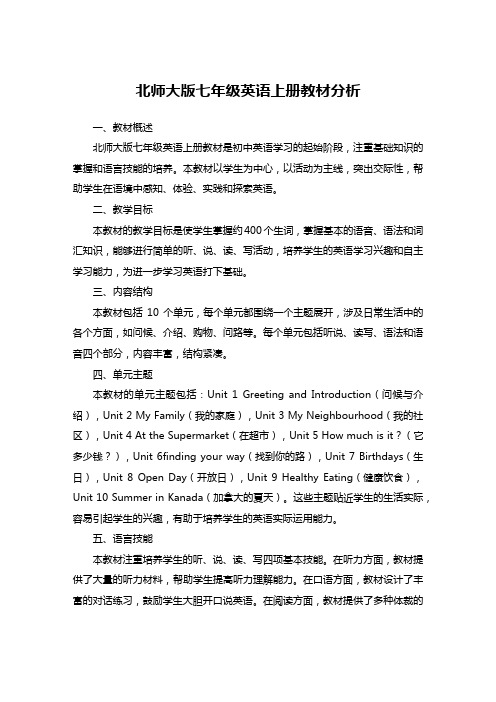
北师大版七年级英语上册教材分析一、教材概述北师大版七年级英语上册教材是初中英语学习的起始阶段,注重基础知识的掌握和语言技能的培养。
本教材以学生为中心,以活动为主线,突出交际性,帮助学生在语境中感知、体验、实践和探索英语。
二、教学目标本教材的教学目标是使学生掌握约400个生词,掌握基本的语音、语法和词汇知识,能够进行简单的听、说、读、写活动,培养学生的英语学习兴趣和自主学习能力,为进一步学习英语打下基础。
三、内容结构本教材包括10个单元,每个单元都围绕一个主题展开,涉及日常生活中的各个方面,如问候、介绍、购物、问路等。
每个单元包括听说、读写、语法和语音四个部分,内容丰富,结构紧凑。
四、单元主题本教材的单元主题包括:Unit 1 Greeting and Introduction(问候与介绍),Unit 2 My Family(我的家庭),Unit 3 My Neighbourhood(我的社区),Unit 4 At the Supermarket(在超市),Unit 5 How much is it?(它多少钱?),Unit 6finding your way(找到你的路),Unit 7 Birthdays(生日),Unit 8 Open Day(开放日),Unit 9 Healthy Eating(健康饮食),Unit 10 Summer in Kanada(加拿大的夏天)。
这些主题贴近学生的生活实际,容易引起学生的兴趣,有助于培养学生的英语实际运用能力。
五、语言技能本教材注重培养学生的听、说、读、写四项基本技能。
在听力方面,教材提供了大量的听力材料,帮助学生提高听力理解能力。
在口语方面,教材设计了丰富的对话练习,鼓励学生大胆开口说英语。
在阅读方面,教材提供了多种体裁的阅读材料,帮助学生提高阅读理解能力。
在写作方面,教材从简单的写句子开始,逐渐过渡到写段落和简短的文章,帮助学生逐步提高写作能力。
北师大版八年级下册英语电子课本可打印
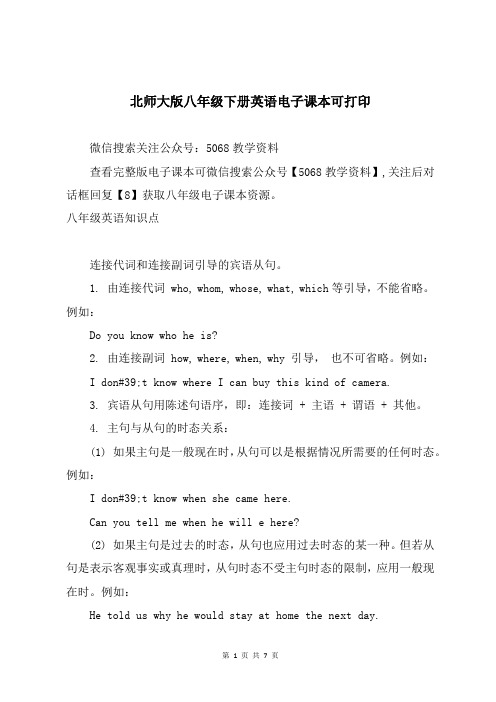
北师大版八年级下册英语电子课本可打印微信搜索关注公众号:5068教学资料查看完整版电子课本可微信搜索公众号【5068教学资料】,关注后对话框回复【8】获取八年级电子课本资源。
八年级英语知识点连接代词和连接副词引导的宾语从句。
1. 由连接代词 who, whom, whose, what, which等引导,不能省略。
例如:Do you know who he is?2. 由连接副词 how, where, when, why 引导,也不可省略。
例如:I don#39;t know where I can buy this kind of camera.3. 宾语从句用陈述句语序,即:连接词 + 主语 + 谓语 + 其他。
4. 主句与从句的时态关系:(1) 如果主句是一般现在时,从句可以是根据情况所需要的任何时态。
例如:I don#39;t know when she came here.Can you tell me when he will e here?(2) 如果主句是过去的时态,从句也应用过去时态的某一种。
但若从句是表示客观事实或真理时,从句时态不受主句时态的限制,应用一般现在时。
例如:He told us why he would stay at home the next day.The teacher explained how the earth goes around the sun. 5. 某些由连接代词或连接副词引导的宾语从句可改为含“特殊疑问词 + 动词不定式”结构的简单句。
例如:Can you tell me where I can buy this book?Can you tell me where to buy this book?八年级下册英语练习题Ⅰ. 词汇根据句意及首字母提示,写出空白处所缺的单词?1. There is one child left a______in the room.2. When the t______lights are red, you must stop and wait.3. Look! It’s raining outside. You’d better put on your raincoat or take an u______ .4. —It’s fine today.—I think so. At l______it’s warm.5. There were so many nice things here, so I couldn’t decide which one to c ______ as a birthday gift for my mom.6. N______Li Lei nor Liu Mei is in the classroom now.7. The old man q______likes collecting coins.8. When did you r______from Australia?9. Did you r______her letter the day before yesterday?10. We must keep our classroom c______every day.B) 用括号内所给单词的适当形式填空?1. We all know that France is a______(Europe) country.2. There are different food cultures between China and______(west) countries.3. Several______(Russia) came to our school last week.4. “Excuse me, can I take this seat?” he said to the young woman______(polite).5. At______(one) I didn’t like him, but now I do.6. I want to make______(friend) with you.7. What are those______(child) doing over there?8. Let’s listen to his______(suggest).9. There are a lot of______(mouse) in the old house.10. The young man fell______(sleep) as soon as he lay down. C) 用方框内所给短语的适当形式填空?take away, run out of, be interested in, in order to, more than, wait in line, at last, take care, put out, get annoyed1. Mr Johnson______Beijing Opera very much.2. You must______ when you go shopping.3. When did the firemen______ the fire?4. There are______ two hundred people present at the meeting.5. We can’t buy that doll because we have______ money.6. These shoes are dirty. Please______ them______.7. I will______ when other people cut in line.8.______ we finished the work on time.9.______ not to break the glass on the table.10.______ improve your English, you must study hard.初二下册英语教学计划一、指导思想以“英语课程标准”为宗旨,适应新课程改革的需要,面向全体学生,提高学生的人文素养,增强实践能力和创新精神。
北师大版初中英语7-9年级(义务教育教科书)课本目录
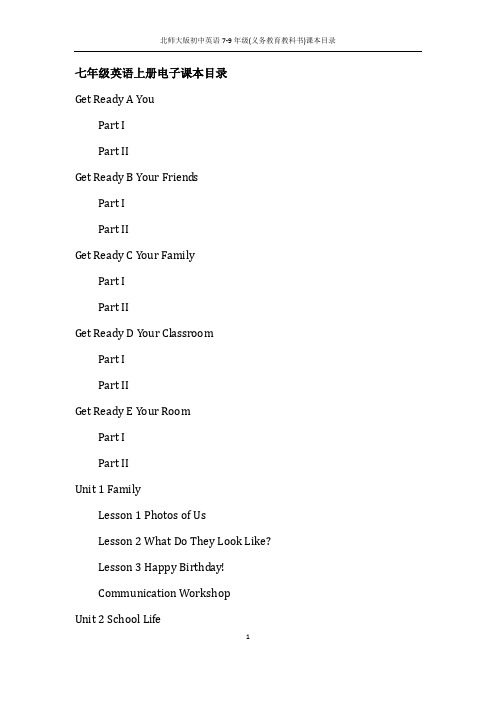
七年级英语上册电子课本目录Get Ready A YouPart IPart IIGet Ready B Your FriendsPart IPart IIGet Ready C Your FamilyPart IPart IIGet Ready D Your ClassroomPart IPart IIGet Ready E Your RoomPart IPart IIUnit 1 FamilyLesson 1 Photos of UsLesson 2 What Do They Look Like?Lesson 3 Happy Birthday!Communication WorkshopUnit 2 School LifeLesson 4 School ThingsLesson 5 Before ClassLesson 6 A School DayCommunication Workshop Unit 3 HomeLesson 7 Time to TidyLesson 8 WhoseBall Is This?Lesson 9 Near My HomeCommunication Workshop Unit 4 Interests and SkillsLesson 10 My InterestsLesson 11 A Skills SurveyLesson 12 China’s Got TalentCommunication Workshop AppendicesLiterature SpotProjectsWorkbookGrammar SummaryNotes to the Texts TapescriptsPicture DictionaryVocabulary in Each UnitWord ListEnglish Names七年级英语下册电子课本目录Unit 1 Daily LifeLesson 1 After SchoolLesson 2 A Dangerous JobLesson 3 Safety FirstCommunication Workshop Unit 2 On the WeekendLesson 4 Helping at HomeLesson 5 Talking to FriendsLesson 6 Going OutCommunication Workshop Unit 3 Food and DrinkLesson 7 Shopping for FoodLesson 8 At a RestaurantLesson 9 Food for SportCommunication Workshop Unit 4 Seasons and WeatherLesson 10 Weather in BeijingLesson 11 Weather Around the WorldLesson 12 Summer HolidayCommunication WorkshopUnit 5 Now and ThenLesson 13 Changes in Our TownLesson 14 My First DayLesson 15 My Favourite TeacherCommunication WorkshopUnit 6 The Animal Kingd omLesson 16 My Favourite AnimalLesson 17 Interesting AnimalsLesson 18 An Animal StoryCommunication Workshop AppendicesLiterature SpotProjectsWorkbookGrammar SummaryNotes to the TextsTapescriptsPicture DictionaryVocabulary in Each UnitWord ListIrregular Verbs后记八年级英语上册电子课本目录Unit 1 Tel evision1 Last Week on TV2 An Interview on TV3 The Big GameCommunication Workshop Unit 2 Teams4 Class Projects5 Teamwork6 A Special TeamCommunication Workshop Unit 3 Faster,Higher,Stronger7 Time to Exercise8 Olympic Winners9 Never Give Up!Communication Workshop Unit 4 Healthy Living10 Going to the Doctor11 Health Advice12 Healthy BonesCommunication WorkshopUnit 5 Helping13 Helping Your Community14 Helping Each Other15 A Young HeroCommunication WorkshopUnit 6 The Unexplained16 Natural Abilities17 True Stories?18 DreamsCommunication WorkshopAppendicesLiterature Spot:Twenty Thousand Leagues und er the Sea Project 1:A Report on a Sports EventProject 2:An Unexplained EventWorkbookGrammar SummaryNotes to the TextsTapescriptsVocabulary in Each UnitWord ListIrregular Verbs后记八年级英语下册电子课本目录Unit 1 Technology and the Future Lesson 1 Schools of the FutureLesson 2 Online LifeLesson 3 Tomorrow's JobsCommunication Workshop Unit 2 CommunicationLesson 4 Animal TalkLesson 5 Meeting PeopleLesson 6 The Texting GenerationCommunication Workshop Unit 3 Festivals and HolidaysLesson 7 Chinese New YearLesson 8 A PicnicLesson 9 ThanksgivingCommunication Workshop Unit 4 Dealing with ProblemsLesson 10 Probl em PageLesson 11 Online TimeLesson 12 Generation GapCommunication Workshop Unit 5 MemoriesLesson 13 A Daughter's LetterLesson 14 Grandpa's MemoriesLesson 15 Life in the 1950sCommunication Workshop Unit 6 DetectivesLesson 16 A Detective Story (I)Lesson 17 A Detective Story (II)Lesson 18 The Mystery WriterCommunication Workshop AppendicesLiterature SpotProjectsWorkbookGrammar SummaryNotes to the TextsTapescriptsVocabulary in Each UnitWord ListIrregular Verbs九年级英语全册电子课本目录Unit 1 LanguageLesson 1 Body LanguageLesson 2 Different Kinds of LanguageLesson 3 Language Learning TipsCommunication WorkshopUnit 2 BooksLesson 4 ClassicsLesson 5 The Book ClubLesson 6 Tom SawyerCommunication WorkshopUnit 3 CreativityLesson 7 A Famous InventorLesson 8 Good or Bad?Lesson 9 Creative MindsCommunication WorkshopUnit 4 SpaceLesson 10 Life in SpaceLesson 11 The Amazing ShenzhouLesson 12 The SpaceshipCommunication WorkshopUnit 5 LiteratureLesson 13 Anne of Green GablesLesson 14 The Dark RoomLesson 15 A Famous WriterCommunication WorkshopUnit 6 Role ModelsLesson 16 Yao MingLesson 17 People in Our LivesLesson 18 Steve JobsCommunication WorkshopUnit 7 JourneysLesson 19 The Silk RoadLesson 20 Life in a JourneyLesson 21 To the South PoleCommunication WorkshopUnit 8 DiscoveriesLesson 22 Famous DiscoveriesLesson 23 Discovery of the YearLesson 24 An Experiment ReportCommunication WorkshopUnit 9 Save the Planet北师大版初中英语7-9年级(义务教育教科书)课本目录Lesson 25 Going GreenLesson 26 Our RiverLesson 27 Tree HeroesCommunication WorkshopAppendicesLiterature SpotProjectsWorkbookGrammar SummaryNotes to the TextsTapescriptsVocabulary in Each UnitWord ListIrregular Verbs11。
北师大版七年级英语上册教材分析

北师大版七年级英语上册教材分析一、教材内容概述北师大版七年级英语上册教材主要围绕学生日常生活、学校生活、文化习俗等话题展开,分为若干单元,每个单元包含课文、词汇、语法、功能等多个部分。
教材注重培养学生的听、说、读、写四项基本技能,通过多样化的教学活动和真实的语言情境,提高学生的语言运用能力。
二、教学目标与要求本册教材的教学目标是帮助学生掌握基本的英语语言知识,包括常用词汇、基本语法结构和日常交际用语。
同时,要求学生能够运用所学知识进行简单的听说读写活动,培养跨文化交际能力。
教学要求包括:准确发音、流畅表达、正确理解和运用所学知识等。
三、教学重点与难点教学重点主要包括词汇量的扩充、基本语法知识的掌握以及日常交际用语的运用。
教学难点则在于学生对语音、语调、语法的掌握和运用,以及跨文化交际能力的培养。
在教学过程中,教师应针对这些重点和难点进行有针对性的教学,帮助学生克服困难,提高学习效果。
四、教学方法与策略为了达到教学目标,教师可以采用多种教学方法与策略。
例如,通过游戏、歌曲、角色扮演等方式激发学生的学习兴趣;利用图片、实物等直观教具帮助学生理解词汇和语法;注重听说训练,提高学生的口语表达能力;通过读写结合的方式培养学生的综合语言运用能力。
五、教材特色分析北师大版七年级英语上册教材具有鲜明的特色。
首先,教材注重学生的实际需求,内容贴近学生生活,有助于提高学生的学习兴趣和积极性。
其次,教材采用多样化的教学活动和真实的语言情境,让学生在实践中学习和运用英语。
此外,教材还配备了丰富的图片和插图,帮助学生更好地理解课文内容。
六、练习题与案例分析教材中的练习题设计合理,包括填空、选择、匹配等多种形式,旨在巩固所学知识,提高学生的语言运用能力。
同时,教材中的案例分析部分也为学生提供了真实的语言运用场景,有助于学生将所学知识应用于实际生活中。
七、评估与反馈机制为了及时了解学生的学习情况,教材设置了多种评估与反馈机制。
Unit+1+Lesson+课件+2024-2025学年北师大版(2024)七年级英语上册

Read and Understand Let’s check your notes. like doing sth
Family member
/
making biscuits kind
Grandpa Ben 72
playing chess clever
Sister Emma /
/ sweet, noisy
Read after the tape
Read and Understand
Now you’re Jack. Please introduce your family members using the notes below.
Who is fast?
caring
sacwcleetiveveterpnoaluitgcefhorstoiwyelneneditlcyestrict
noisy
Review, Activate and Share
How many family members do you have? Who are they? What are your family members like? Describe your family members to your partner. Use the ideas in the box to help you.
Unit 1 Family
Lesson 1 Knowing My Family
Activate and Share
• kind • clever • sweet • active • caring • cool • polite • noisy
初中英语北师大版八年级上册《Lesson 15 A Young Hero 》课件
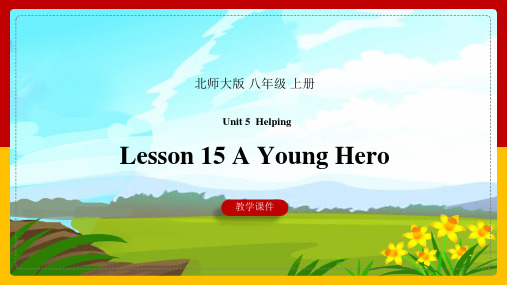
told mother about tXXXami but didn’t understand
left the beach
were sleeping or taking a shower
warned others about tXXXami
in the hotel
because of Tilly’s warning
What were you doing this morning at six o’ clock?
I was sleeping.
Listen and circle the sentences you hear.
Discussion
Work with a partner. Read a sentence. Can your partner guess which sentence it is?
because & because of
because bacause of
“由于,由于”
后面接句子
“由于,由于”
后面接名词、代词、动名词 等
Complete the sentences with because or because of.
1. The hotel was empty _b_e_c_a_u_s_e_ everyone ran away. 2. We have to stay at home _b_e_c_a_u_s_e_o_f the rain. 3. B__ec_a_u_s_e__o_f the tXXXami, many people died. 4. _B_e_c_a_u_se_ Tilly warned them, they were safe.
Read the text an) The water went out very far and it was bubXXX ,too. ( 1 ) Tilly’s teacher talked about tXXXami in her geography class. ( 6 ) The hotel workers helped guests get to a safer place. ( 2 ) Tilly was walking on the beach and enjoying the XXX. ( 4 ) Tilly told her mother tsumani was coming but she didn't understand. ( 5 ) Tilly shouted to her dad and dad warned others.
北师大版七年级下册英语课件 Lesson 9 Food for sport (共47张PPT)
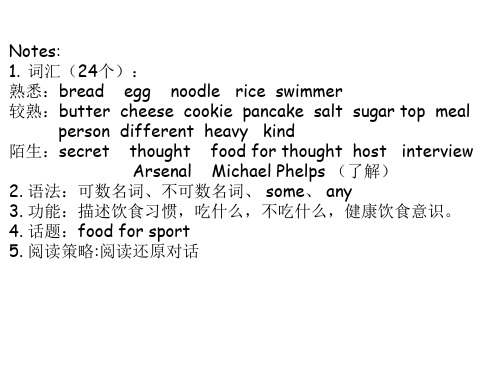
Host’s words:
● How about swimmers? Do they eat any beef?
Swimmers usually eat……
问答关系+关键词
● Really? But Michael Phelps eats all those things.
Yes. He…
肯定上文+人称
● Is each sport different?
问句类型+关键词
Yes, and each person is different, too.
● Well, that’s food for thought. Thank you very much.
You are welcome.
交际用语
c) Is each sport different?
d) How about swimmers? Do they问ea答t a关ny系be+ef关? 键词
Host: 2 _________________________ Dr Hill: Yes. He can eat three pancakes, three cheese
1W.hRoeaarde tthheespreakdeiros innttheervinietewrv.iew?
interviewer interviewee
host
Dr Hill
2. Read and complete the host’s words.
a) Really? But Michael Phelps eats all those things.
13、He who seize the right moment, is the right man.谁把握机遇,谁就心想事成。2021/9/42021/9/42021/9/42021/9/49/4/2021 •14、谁要是自己还没有发展培养和教育好,他就不能发展培养和教育别人。2021年9月4日星期六2021/9/42021/9/42021/9/4 •15、一年之计,莫如树谷;十年之计,莫如树木;终身之计,莫如树人。2021年9月2021/9/42021/9/42021/9/49/4/2021 •16、教学的目的是培养学生自己学习,自己研究,用自己的头脑来想,用自己的眼睛看,用自己的手来做这种精神。2021/9/42021/9/4September 4, 2021 •17、儿童是中心,教育的措施便围绕他们而组织起来。2021/9/42021/9/42021/9/42021/9/4
初中英语北师大版八年级上册《Lesson 14 Helping Each Other 》课件

4. Why did XXX feel surprised? Because Carrie was the girl she helped that morning.
Retell Para2
Finally, XXX got to school.
Байду номын сангаас
Complete the sentences with the words below.
nervous, tried, finally, events, wonder
1. We _f_i_n_a_l_ly_ found a nice present for our father. 2. I __w_o_n_d_e_r__ why Kate is so happy. 3. Chris often gets _n__er_v_o_u__s before he makes a speech in public. 4. The sports meet is one of the most important _e_v_e_n_t_s__ in our
北师大版 八年级 上册
Unit 5 Helping
Lesson 14 Helping Each Other
教学课件
Warm up
The rose in her hand, the flavor in mine.
赠人玫瑰,手有余香
What do you think of the people who help others?
3 XXX sat down beside a girl. 1 XXX was walking slowly to her new school. 4 Carrie shared her book with XXX. 2 A girl fell off her bike. 5 Carrie and XXX became good friends.
北师大版《初中英语》七年级下册教材
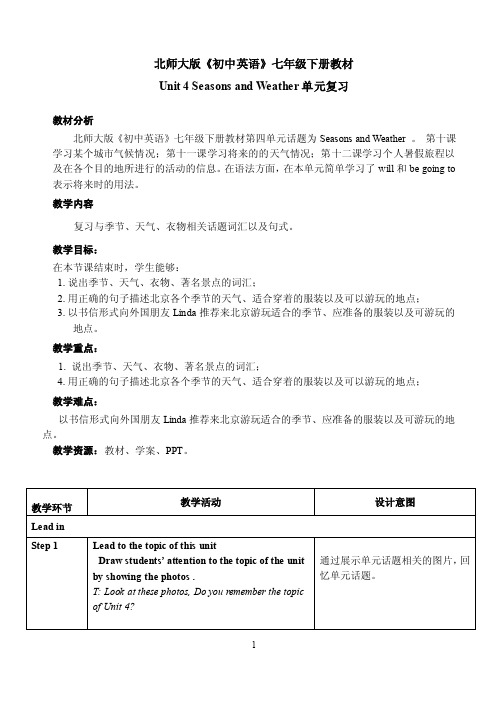
北师大版《初中英语》七年级下册教材Unit 4 Seasons and W eather单元复习教材分析北师大版《初中英语》七年级下册教材第四单元话题为Seasons and Weather 。
第十课学习某个城市气候情况;第十一课学习将来的的天气情况;第十二课学习个人暑假旅程以及在各个目的地所进行的活动的信息。
在语法方面,在本单元简单学习了will和be going to 表示将来时的用法。
教学内容复习与季节、天气、衣物相关话题词汇以及句式。
教学目标:在本节课结束时,学生能够:1.说出季节、天气、衣物、著名景点的词汇;2.用正确的句子描述北京各个季节的天气、适合穿着的服装以及可以游玩的地点;3.以书信形式向外国朋友Linda推荐来北京游玩适合的季节、应准备的服装以及可游玩的地点。
教学重点:1. 说出季节、天气、衣物、著名景点的词汇;4.用正确的句子描述北京各个季节的天气、适合穿着的服装以及可以游玩的地点;教学难点:以书信形式向外国朋友Linda推荐来北京游玩适合的季节、应准备的服装以及可游玩的地点。
教学资源:教材、学案、PPT。
教学环节教学活动设计意图Lead inStep 1 Lead to the topic of this unitDraw students’ attention to the topic of the unit by showing the photos .T: Look at these photos, Do you remember the topic of Unit 4? 通过展示单元话题相关的图片,回忆单元话题。
RevisionStep 2 BrainstormingStudents brainstorm the main aspects.触发器点击T: My friend Linda wants to visit Beijing. Whatthings should she think about ?S: Season, weather, clothes, famous places,activities. 通过真实的任务激发学生思考,说出旅行前需要考虑的几方面内容,以此作为本课的复习框架Step 3 1.Review the words and sentences about weather.T: How many seasons are there in Beijing?What’rethey?S:...T:What’s the weather like inspring/summer/autumn/winter in Beijing?S:...1) Ss brainstorm the words and sentences aboutweather in each season.2) Ss complete the sentences according to thepicture.3) Review the sentence structure.2.Pair-work:Ss work in pairs, talk about the best season to visitBeijing.A:Which is the best season to visit Beijing?B:A:What’s the weather like in...?B:Ss shift their turns 学生在教师的引导下通过回答问题复习有关天气的词汇及表达天气的句式。
北师大初中英语教材分析
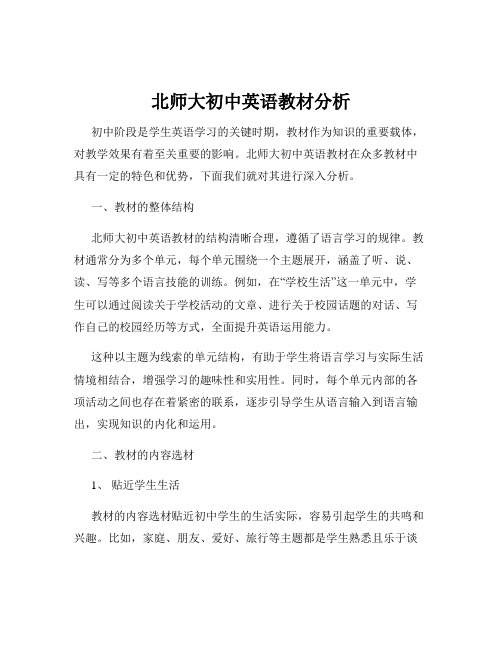
北师大初中英语教材分析初中阶段是学生英语学习的关键时期,教材作为知识的重要载体,对教学效果有着至关重要的影响。
北师大初中英语教材在众多教材中具有一定的特色和优势,下面我们就对其进行深入分析。
一、教材的整体结构北师大初中英语教材的结构清晰合理,遵循了语言学习的规律。
教材通常分为多个单元,每个单元围绕一个主题展开,涵盖了听、说、读、写等多个语言技能的训练。
例如,在“学校生活”这一单元中,学生可以通过阅读关于学校活动的文章、进行关于校园话题的对话、写作自己的校园经历等方式,全面提升英语运用能力。
这种以主题为线索的单元结构,有助于学生将语言学习与实际生活情境相结合,增强学习的趣味性和实用性。
同时,每个单元内部的各项活动之间也存在着紧密的联系,逐步引导学生从语言输入到语言输出,实现知识的内化和运用。
二、教材的内容选材1、贴近学生生活教材的内容选材贴近初中学生的生活实际,容易引起学生的共鸣和兴趣。
比如,家庭、朋友、爱好、旅行等主题都是学生熟悉且乐于谈论的话题。
通过学习这些内容,学生能够在真实的情境中运用所学的英语知识,提高语言交流的能力。
2、文化元素丰富教材中融入了丰富的文化元素,不仅介绍了英语国家的文化,还注重引导学生对比中西方文化的差异。
这有助于培养学生的跨文化意识和交际能力,使他们在学习英语的同时,拓宽国际视野,增进对不同文化的理解和尊重。
3、时代性强教材内容能够与时俱进,反映当下社会的发展和变化。
例如,在科技、环保、社会热点等方面都有涉及,让学生能够接触到最新的语言表达方式和相关话题,增强他们对现实世界的关注和思考能力。
三、教材的语言知识体系1、语法知识北师大初中英语教材对语法知识的编排循序渐进,由易到难。
语法点的讲解简洁明了,并通过大量的例句和练习帮助学生巩固和掌握。
同时,教材注重语法知识在实际语境中的运用,避免了单纯的语法规则讲解,使学生能够更好地理解和运用语法。
2、词汇教材中的词汇量适中,涵盖了初中阶段必备的基础词汇和常用词汇。
- 1、下载文档前请自行甄别文档内容的完整性,平台不提供额外的编辑、内容补充、找答案等附加服务。
- 2、"仅部分预览"的文档,不可在线预览部分如存在完整性等问题,可反馈申请退款(可完整预览的文档不适用该条件!)。
- 3、如文档侵犯您的权益,请联系客服反馈,我们会尽快为您处理(人工客服工作时间:9:00-18:30)。
(8min)
Language
in use
(7min)
引导学生进一步理解现在完成时的意义,总结have been to和have gone to的用法
1.学生进一步理解现在完成时的意义,总结have been to和have gone to的用法
2. 学生完成work it out
1)学生齐读黄框中的单词
2)区分“have never been’’和“haven’t been”
3)学生选择正确的词组填空
4)小组核对答案
5) 学生跟读录音核对答案
6)全班核对答案
Step 3. 获取文章大意,选择恰当选项
Q:What’stheletter mainly about
A:theintroduction ofWestern China
利用图片,引出本课话题
Language
input
(23min)
一.阅读信件选词填空,获取文章主旨要义
Step 1. 了解文章的体裁—信件
T:Open your books. Turn toP78. Look at .
1) Ask Ss to number the paragraphs.
2) Ask Ss to find out whowrote the letterand who receivedthe letter.
B:thechanges ofWestern China
C: thenewschools and roads inWestern China
1)学生选择恰当标题
2)小组核对答案
3) 全班核对答案
二.阅读2, 3, 4, 5段,选择段落大意
1.教师给出2, 3, 4, 5段段落大意
T: What’s each paragraph mainly about Let’s read paragraph 2, 3, 4, 5 and match them with the titles. Please take out your worksheet, finish exercise 1
教学重点和难点
(一)教学重点
1.学生能够通过选词填空等不同的方式,获取西部发生巨大变化的不同信息。
2. 学生能够通过阅读短文,理解现在完成时表示“去过某地”及“去了某地”的用法和意义。
(二)教学难点
学生能够正确运用现在完成时及相关话题词汇,在真实的语境下笔头描述已经完成的活动。
教学资p 2. 引导学生阅读信件,选择正确的词填空
T : Let’s get more information about the letter.Please readthe words in the yellow box together, then fill in theblanks withthem.
教学过程
教学环节与时间安排
教与学的过程
设计意图
Lead-in
(2 min)
教师出示图片
T : Have you ever been toWestern China
Ss:…..
T:Inthislesson,ourfriend Brian will talk about this area.Today we will learn about L48 We have made a lot of progress.
在情景导入环节,为了激发学生的学习兴趣,我利用图片创设情景导入新课,让学生在教师一步步的引导下,关注本课的话题,并巧妙的与教材选用的语言材料进行衔接。
本节课语言输入的主要方式是阅读教材中的文字材料。在这个环节中,通过选词填空、选择恰当标题、选择段落大意、完成表格、判断正误等方式,引导学生理解文段含义。通过理解难句的方式,引导学生在语境中理解生词含义并学习生词的音、形、义。
教材分析
本单元Western China为初中英语北师大版教材第十四册的第12单元,话题是中国的西部,位于课标话题22历史与地理下的(1)中国的历史和概况。本单元是一个复习单元, 学生在学习本单元课文的同时对语法项目中的一般现在时、一般过去时、现在完成时进行了复习。
本课是本单元的第4课, 是在45课学习中国西部的地理、46课学习中国西部的志愿者生活、47课学习中国西部的旅游资源的基础上,借助于信件的形式学习近几年中国西部的变化,同时体会现在完成时表示“去过某地”及“去了某地”的用法和意义,本课是第12单元知识内容上的延伸。
4. Brian is looking forward to receiving a letter from his cousin.
5. The new teacher has been to many places.Right now, she has gone toBeijing.
1. 学生独立完成判断正误
学生通过观察例句进一步体会现在完成时的意义
引导学生在真实的情境中综合运用语言,实现本课的语言输出
Homework
1. Listen to the tape and read the letter.
2. Polish your letter and make it perfect
巩固所学,落实到笔头
板书设计
2. 两人一组核对答案
3. 全班核对答案并引导学生语境中理解短语“so that”“hear from”,“has been to” 和“has gone to”的含义
培养学生理解段落中各句子之间逻辑关系的能力。
培养学生归纳文章的主旨要义的阅读能力
培养学生通过自主阅读准确捕捉细节信息的能力
培养学生通过上下文语境猜测生词和理解难句的能力
Step 1完成表格
Qianmen
Street
In the past
What was it like
Now
What is it like
road
building
shop
1.两人一组进行讨论,并完成表格内容
2.全班核对答案
Step2 书面表达
1.让学生根据表格内容和提示词完成回信
2.用实物投影进行个别展示
教学目标
通过本课学习,学生能够:
1.通过选词填空、选择恰当的标题、选择正确的段意、完成表格和判断正误等形式,获取西部发生巨大变化的不同信息。
2.通过上下文语境,猜测生词、理解难句的含义。
3.通过阅读短文,理解现在完成时表示“去过某地”及“去了某地”的用法和意义。
4. 在真实的语境下正确运用现在完成时及相关话题词汇,笔头描述已经完成的活动。
初中英语北师大版教材
Unit 12Western China
Lesson 48
We have made a lot of progress.
教学设计
丰台八中
韩宇
英语教学设计
教师姓名:韩宇 学校:丰台八中
教材:《北京市义务教育课程改革实验教材》北师大版
课题:Unit 12Western China
Lesson 48We have made a lot of progress.(1)
3. 全班订正答案
4. 全班齐读
综合语言运用
你从小就居住在北京,并且去过前门大街好多次,见证了它各个方面的巨大变化,请你给Brian写封回信, 向他讲述前门大街的巨大变化。(不少于50词)
提示词:live,since,have been to, change alot, there be, road, building,air, population
1.In the past ,there weren’t any computers, new books or magazines in the school.
2. Brian has ever read Harry Potter.
3.Brian wants to get his cousin’s phone number to call him.
3.绝大部分学生在小组活动中,互相帮助,提高了交流合作的意识。
4.部分学生在运用现在完成时和相关话题词汇准确笔头描述已经完成的活动还存在一定的困难,需要在下一步的教学中继续巩固训练。
1. 学生独立完成表格
2. 两人一组核对答案
3. 全班核对答案
4.在处理每一部分表格信息的同时处理其它文中细节信息。
Q1:Is Brian happy to see the highway How do you know
Q2:What arevillagersdoing now
(利用village猜测本课新词villager)
学情分析
学生已经在第14册的第10单元, 第11单元的前两课学习了现在完成时的结构和用法。在第12单元的前3课学习了一些关于中国西部的话题词汇。从词汇和语言知识上有一定的储备,为学生学习本课奠定了一定的基础。
我的学生是普通班学生,英语语言能力参差不齐,本节课现在完成时表示“去过某地”及“去了某地”的用法和意义对一部分学生在理解和使用上可能有一定的难度,因此在教学设计中我准备采取分解难点和搭设小台阶的教学方法,来帮助学生进行语言学习。而运用现在完成时及相关话题词汇笔头描述已经完成的活动是学生在本课学习中需要突破的难点。
Lesson 48 We have made a lot of progress (1)
have/has been to 去过…
have/has gone to 去了…
教学效果及评价
本节课是从已授课的角度进行评价:
1.绝大多数的学生能够读懂关于中国西部发生变化的简单描述。
2.大部分学生能够理解have been to和have gone to的意义并能够在真实的语境下正确运用。
设计思路
《英语课程标准》强调教学要注重知识的发展及知识的传授过程,摒弃过于重视知识讲授的教学方式,英语学习要符合学生的心理和生理特点,遵循语言学习的规律,力求满足不同类型和不同层次学生的需求,培养学生学习英语的兴趣,采用活动途径,倡导体验参与。因此在本课书的教学中,我比较关注学生通过自己的探索获取知识的过程,尽量采用提问等方式引导他们主动探究,激发学生的学习兴趣,体现学生的学习主体地位。我按照“语言接触—理解体验—语言聚焦—语言运用”的设计思路,对本节课的教学进行了设计,并确立了以下四个教学环节:
